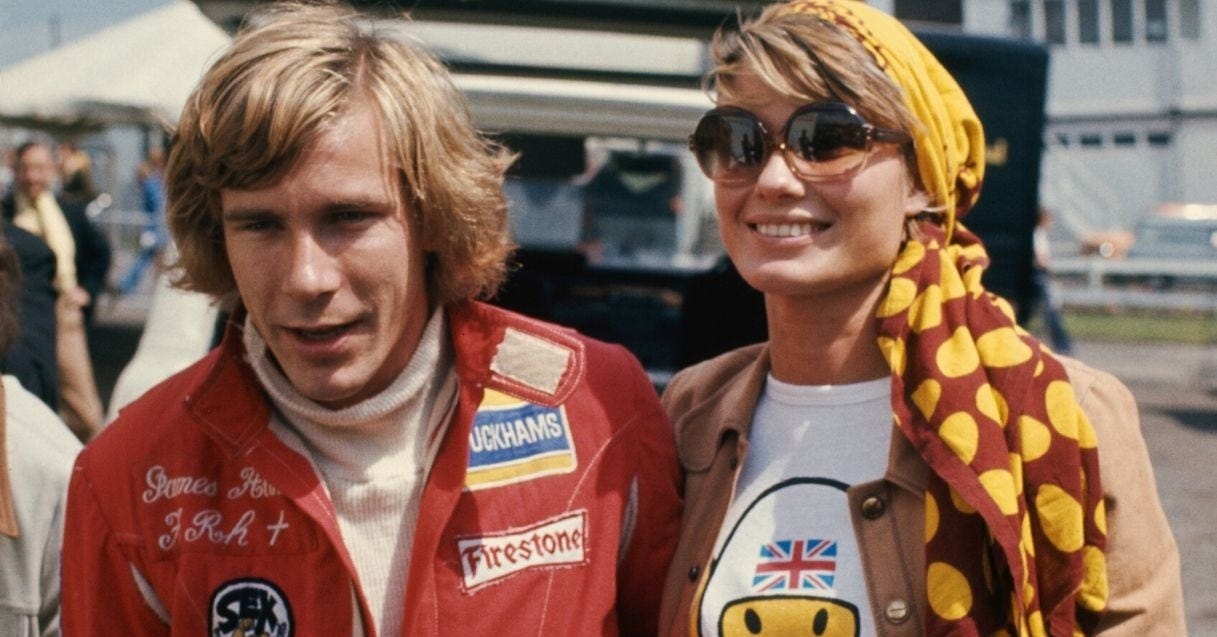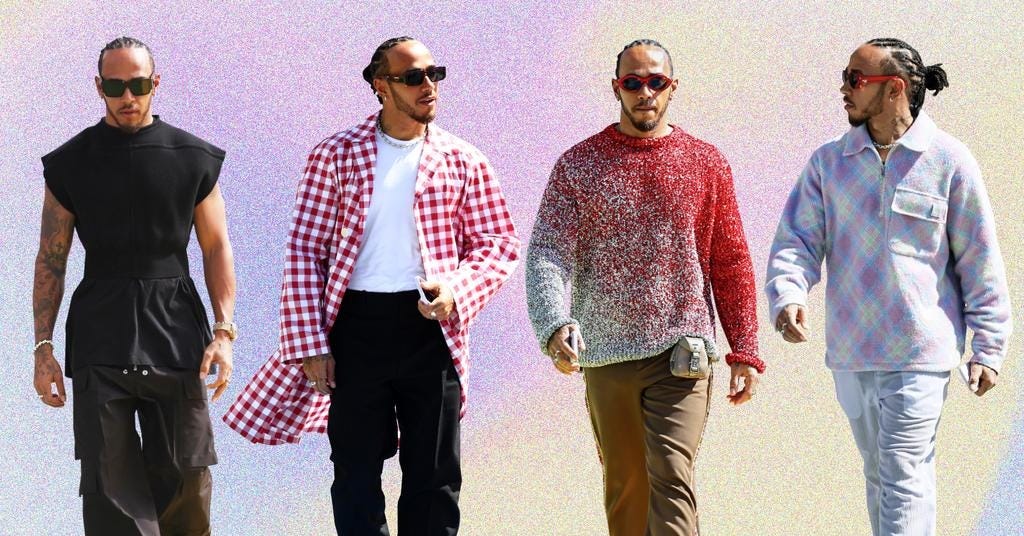the Alexandra Saint Mleux effect
from galleries to grands prix: the art-girl soft power in the age of Formula 1
Whether you watch F1 or not, you have probably been exposed to the current F1 IT GIRL and French fashion icon, Alexandra Saint-Mleux. And I am here to confirm that she is indeed that girl for many reasons. Alexandra is currently the WAG (wife and girlfriend) to Ferrari golden boy, Charles Leclerc (a F1 driver for Ferrari). As an avid F1 consumer, I have always admired the WAGs, but I feel like Alexandra has taken it by storm. Plus, as a longtime admirer of the sport, it has been rare to see someone rise to the level of fame that Alexandra has achieved in a relatively short time frame. This is very admirable, and I find the current discourse around her even more interesting.
A DISCLAIMER.
Before I dive into this, I want to preface that Alexandra is more than her WAG title. From what is known, she is an art history major specializing in 20th-century art at École du Louvre. Alexandra has held various internships in different art spaces and is currently working in art coordinating and public relations at Kamil Art Gallery in Monaco. Also, she has taken part in interviewing artists at Basel Art exhibitions around the world. She shares a lot of her art history knowledge and discusses pieces all across the globe on her Instagram page dedicated to art. I wanted to acknowledge her career and education because some of the hatred she faces is from people who consider her a “freeloader” or are envious of her position. Like anyone in her position, she has received a lot of love and a lot of unjustifiable hate for her fame. It is easy to assume people in her position are exposed to this treatment - both the love and the hate (however, the hate does stem from a lot of misogyny and racism - but that is another article). However, the truth is Alexandra is an accomplished woman with her interests, career, education and wealth. She should not be reduced to her relationship with Charles, as many women tend to be in her position.
Disclaimer done. Let’s get back to the program now.
Alexandra has become a public figure, due to the level of fame her partner and his career have, but she has established and forged her current fame. Before anyone starts to state the obvious, I will do the acknowledgements myself - I am fully aware that being a “wag” (wife or girlfriend) of one of the 20 F1 drivers in the world, F1 is a very popular followed sport and that any F1 driver partner does come with an automatic public figure status and fame. I am not denying any of these facts, and I am not writing this unaware of the implications of dating Charles Leclerc.
While I believe that Alexandra has benefited from the status of her partner, I think it is important to acknowledge that she has built her career and identity outside of it. She was first spotted in some behind-the-scenes fashion week content Charles was filming, then officially spotted with him at Wimbledon in July 2023 and then seen on the paddock in October 2023. Her first appearance on the paddock was imprinted in the minds of the Leclerc and Ferrari fandom due to her famous posture. Also, it stirred many emotions among the fandom. However, one thing was consistent: everyone was curious about her and her amazing posture, and I truly do mean everyone. Unlike the other F1 WAGs, Alexandra was very private - she had no public social media besides a TikTok and an art Instagram, she had no information about her on the internet, and she was not a public person. People became very intrigued and curious, and they wanted to know more. The only access Alexandra had granted to herself was her public appearances on the paddock or with Charles and her TikTok. While this may or may not have been a conscious decision she made, it was a smart strategy.
But let's take a break and do a quick debrief on the importance of media and fashion in F1 on drivers and WAG culture.
Like any sport, F1 has a traditional media presence on sports channels, paparazzi and social media. Earlier, the drivers were the key focus, and they gained a lot of exposure and opportunities with these pap and media moments. As F1 drivers were being papped more, their WAGs were being paparazzied. This forced exposure created a sort of eviction out of the private and mysterious WAG culture. As time progressed and the internet evolved, we saw that WAGs were capable of using this attention to their benefit, boosting their existing careers or building new ones. They got their opportunities, independent of F1 drivers, and the WAG culture started to shift.
In recent years, F1 and fashion have forged an interesting and successful partnership. This is evident with Sir Lewis Hamilton, who has pioneered and bridged the gap between F1 and fashion in a refreshingly and creatively innovative way. Now, fashion plays an impactful role in F1, whether it is on or off the paddock - drivers and their WAGs are experimenting. Before this, F1 fashion on and off the paddock was “conservative and preppy” or “prim and proper/tailored,” coded. However, with the influence of Sir Lewis Hamilton, we are now in the polished, branded, and curated era, also known as the “Instagrammable era,” of fashion and glam among the drivers and WAGs.
Also, the media, sponsors and brand partnerships in F1 have pushed the impact of fashion further for F1 drivers and their WAGs. However, like the sport itself, the sponsors and partnerships have always been luxurious, which means the fashion has been too. F1 has been notoriously referred to as the rich people's playground, which means its fashion has been for the rich as well. While this was not a problem before, because all of this was attainable and accessible for the audience partaking in the sport, in recent years, the audience has shifted.
Well, F1 had to have a rebrand, for good reason - well, the reason being money. This sport isn’t cheap, and these liveries aren’t going to pay for themselves, but the sport was hitting a dying end. The demographic of the sport was aging, and young people were not as interested in or involved in the idea.
So the remedy to this - get a larger audience. The solution: make it more accessible and relatable. How was it done - Netflix docu-series on F1 “Formula 1: Drive to Survive “.
Enter the new era of F1, with a much larger and enthusiastic audience with a deep understanding and love for this sport. This was a smart choice because of the accessibility to the sport, which in turn produced a diverse audience.
This new popularity and demographic rise have impacted the fashion and brand partnership among the F1 drivers and WAGs. They have started collaborating with affordable brands to cater to the newer audience and be relatable.
Even though these collaborations exist, when we see WAGs or drivers on and off the paddock, they are still seemingly unaffordable and not relatable in a fashion sense. Most paddock appearances with WAGs are wearing designer wear and unaffordable collaborations. And this is normal for them; they can afford these brands and have connections to them. But there was no sense of relatability, only aspirations with their fashion.
BUT this is where Alexandra comes in.
Alexandra's private approach to her online presence led to people being very curious about her, which led to putting a larger emphasis on her paddock and public appearances. And she did not disappoint, Alexandra's posture, vibe and style exceeded everyone’s expectations. Her rise to popularity came from her relatability to women; she wore beautiful clothes and styled so well, but they were affordable. Alexandra can blend affordable statement pieces and luxurious fashions in a very seamless way. On the paddock and sometimes off, she is seen wearing very popular and attainable brands like Meshki, Realisation Par, With Jean and Cult Gaia. While these brands aren’t necessarily affordable brands to all, they are also not something that is restricted to the upper and richer class of the F1 audience. These are brands that the larger majority of the F1 audience had access to and are attainable, more so than haute couture houses that were frequently showcased on the paddock. Alexandra attained a sense of relatability by using these brands and showcasing that her style was not limited to a specific type of brand or fashion house. Also, her style is relatable and aspirational; it is a very feminine, soft girl aesthetic, and she made it in an attainable way. In the best way possible, Alexandra has made a soft girl Pinterest board come to life, and she is showing you how to do it and making it affordable.
Furthermore, her outfits are not outrageous - they are quite simple to replicate in real life. In the most literal sense, the general population can see themselves wearing these outfits. For the most part, outfits seen in these big media settings are fashion-forward in a non-replicating way for the general public. For example, we all know influencers' fashion in these events can be very fashion-forward and hard to replicate as everyday wear or elevated everyday wear. Also, a lot of the influencers or stardom fashion seen in the paddock can be unique pieces that are hard to replicate and wear without feeling too out there. While I have no quarrels with unique fashion choices and people expressing themselves with fashion, I do believe that it takes a lot of confidence that not a lot of us have access to, including myself. Whereas Alexandra has curated looks that can be replicated and affordable, adding more to her attainability and relatability factor. ALSO, she is an outfit repeater. I know this may not be a big thing, but in this world, this is rare to see.
Beyond this, her aesthetic aligns with her vibe; her fashion and relatability also match her vibe. Alexandra's cohesiveness between her personality, persona and presentation solidifies her authenticity. I believe the cohesiveness that she presents is what draws people. And there is more to her relatability than her fashion; it's her use of the Gen Z lifestyle and taste that adds to it. Alexandra uses products from Rhode and Charlotte Tilbury and was seen using the famous cover that is popular among Gen Z. Beyond these brands, she interacts with her followers with very Gen Z responses and terminology. Her comments and responses only add to her authenticity as well. Her relatability extends from her fashion and glam via her style and how she carries herself.
Alexandra built this hype and mystery around her that led to an explosion when she made her Instagram public. To explain it in the best way, her Instagram felt like you were looking at your aesthetic friend's feed on Instagram. It did not feel social influencer esq, it feels very thoughtful and curated in a way that makes sense to her persona. It felt personal. It felt authentic to her.
And honestly, it is refreshing to witness.
As Alexandra’s social media career builds and her popularity rises, she remains authentic and relatable. She collaborates with brands that she wears and adores. Recently, she has had campaigns with Rhode Beauty (the release of their new shade), Meshki (collaboration on a resort collection), and Nina Ricci (as an ambassador). While remaining true to her taste and persona, she has worked with these brands, producing products and media for these campaigns that she would wear and post. This is refreshing, it is nice to see creators work with brands they undoubtedly use.
I guess this is all to say - I hope she remains relatable and authentic because I am intrigued to see her future.
<33333,
shafs













